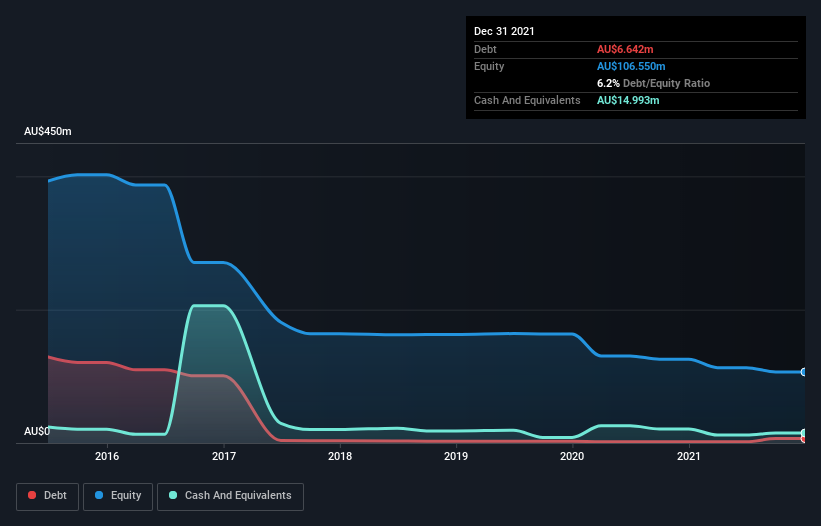Is A2B Australia (ASX:A2B) A Risky Investment?
The external fund manager backed by Berkshire Hathaway's Charlie Munger, Li Lu, makes no bones about it when he says 'The biggest investment risk is not the volatility of prices, but whether you will suffer a permanent loss of capital.' When we think about how risky a company is, we always like to look at its use of debt, since debt overload can lead to ruin. As with many other companies A2B Australia Limited (ASX:A2B) makes use of debt. But the real question is whether this debt is making the company risky.
What Risk Does Debt Bring?
Debt and other liabilities become risky for a business when it cannot easily fulfill those obligations, either with free cash flow or by raising capital at an attractive price. Ultimately, if the company can't fulfill its legal obligations to repay debt, shareholders could walk away with nothing. However, a more common (but still painful) scenario is that it has to raise new equity capital at a low price, thus permanently diluting shareholders. Of course, debt can be an important tool in businesses, particularly capital heavy businesses. When we examine debt levels, we first consider both cash and debt levels, together.
Check out our latest analysis for A2B Australia
What Is A2B Australia's Debt?
The image below, which you can click on for greater detail, shows that at December 2021 A2B Australia had debt of AU$6.64m, up from AU$1.93m in one year. However, it does have AU$15.0m in cash offsetting this, leading to net cash of AU$8.35m.
A Look At A2B Australia's Liabilities
The latest balance sheet data shows that A2B Australia had liabilities of AU$58.7m due within a year, and liabilities of AU$16.9m falling due after that. On the other hand, it had cash of AU$15.0m and AU$52.7m worth of receivables due within a year. So it has liabilities totalling AU$8.00m more than its cash and near-term receivables, combined.
Given A2B Australia has a market capitalization of AU$165.0m, it's hard to believe these liabilities pose much threat. However, we do think it is worth keeping an eye on its balance sheet strength, as it may change over time. Despite its noteworthy liabilities, A2B Australia boasts net cash, so it's fair to say it does not have a heavy debt load! There's no doubt that we learn most about debt from the balance sheet. But it is A2B Australia's earnings that will influence how the balance sheet holds up in the future. So if you're keen to discover more about its earnings, it might be worth checking out this graph of its long term earnings trend.
In the last year A2B Australia had a loss before interest and tax, and actually shrunk its revenue by 16%, to AU$110m. We would much prefer see growth.
So How Risky Is A2B Australia?
Statistically speaking companies that lose money are riskier than those that make money. And in the last year A2B Australia had an earnings before interest and tax (EBIT) loss, truth be told. And over the same period it saw negative free cash outflow of AU$9.2m and booked a AU$19m accounting loss. With only AU$8.35m on the balance sheet, it would appear that its going to need to raise capital again soon. Overall, we'd say the stock is a bit risky, and we're usually very cautious until we see positive free cash flow. There's no doubt that we learn most about debt from the balance sheet. However, not all investment risk resides within the balance sheet - far from it. These risks can be hard to spot. Every company has them, and we've spotted 1 warning sign for A2B Australia you should know about.
At the end of the day, it's often better to focus on companies that are free from net debt. You can access our special list of such companies (all with a track record of profit growth). It's free.
Have feedback on this article? Concerned about the content? Get in touch with us directly. Alternatively, email editorial-team (at) simplywallst.com.
This article by Simply Wall St is general in nature. We provide commentary based on historical data and analyst forecasts only using an unbiased methodology and our articles are not intended to be financial advice. It does not constitute a recommendation to buy or sell any stock, and does not take account of your objectives, or your financial situation. We aim to bring you long-term focused analysis driven by fundamental data. Note that our analysis may not factor in the latest price-sensitive company announcements or qualitative material. Simply Wall St has no position in any stocks mentioned.

 Yahoo Finance
Yahoo Finance 
